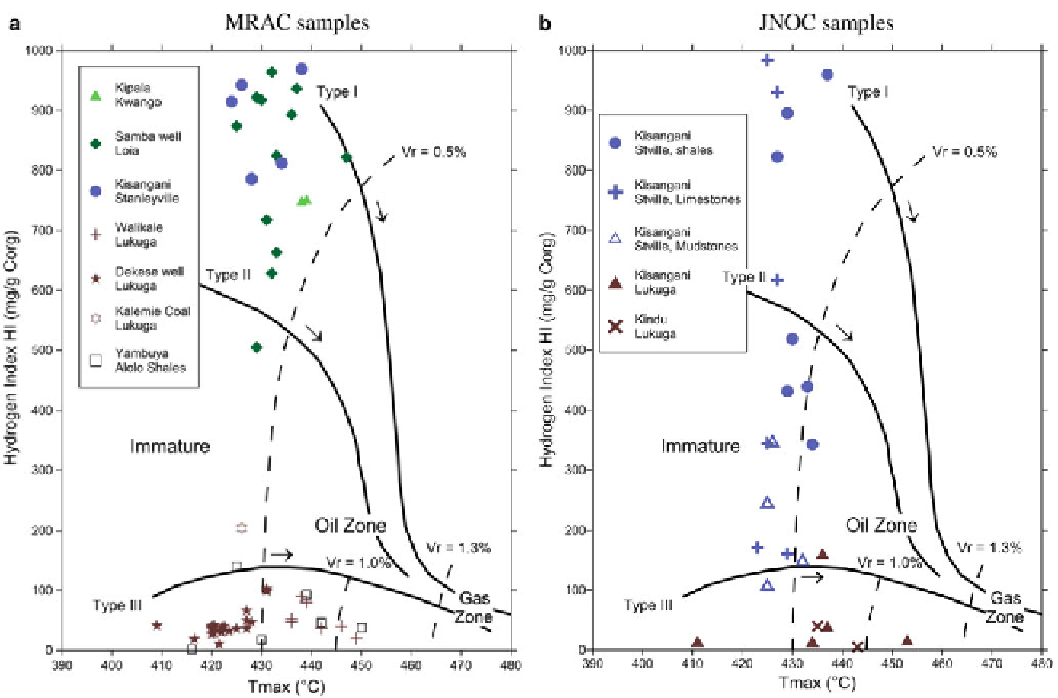Geology Reference
In-Depth Information
Fig. 18.3
Characterization of kerogen type on a Van-Krevelen
equivalent diagram (Espitalie et al.
1977
), using Rock-Eval Hydrogen
and Oxygen indexes (HI and HO).
Bold lines
show the evolution path
of kerogen types with thermal maturation (along the direction shown
by the
arrows
). Kerogen type I: rich in aliphatic chains and poor in
aromatics, derived from algal lipids or enriched by microbial activity,
typical of lacustrine organic-matter; type II: richer in aromatics,
usually related to marine organic matter deposited on a reducing
environment but also formed by a combination algae (type I) and
terrestrial (Type III) organic matter, Type III: aromatics and oxy-
genated functions, derived from terrestrial higher plants (Tissot and
Welte
1978
). (
a
) RMCA samples, analyzed by RWTH Aachen
(Sachse et al.
2012
), with two samples of Kipala shales from
Kadima (
2007
).
(
b
)
JNOC samples
(JNOC
1984
). Data from
Tables
18.1
and
18.2
sandstones and contain very little quantity of organic matter
(C
org
¼
Similarly, samples of the Loia Group (Cretaceous) are rich
in C
org
in the Samba well (Couches 4 of Cahen et al.
1959
),
but very poor in the Dekese well (Couches C of Cahen et al.
1960
) and in the region of Kananga (JNOC samples). Those
from the Samba well display also high Hydrogen Indexes
(~800mgHCequivalen /gC
org
) and medium Oxygen
Indexes (50-60 mg CO2/gC
org
).
Sulphur content, microscopic observations, n-alcane
and biomarker patterns (Sachse et al.
2012
) show that
brown-grey shales of the Loia and Stanleyville Groups
are composed predominantly of algae-derived aquatic
organic matter and small amounts of terrestrial higher
plant material. The range of composition of the
Stanleyville samples analysed by JNOC (Fig.
18.3b
)
might therefore reflect various proportions of the end-
members (type I algae-derived and type III terrestrial
higher plant-derived) rather than the presence of marine
type II organic matter.
0.43 %, Table
18.3
).Themostorganic-richfaciesis
the brown-grey shales (termed bituminous shales by Passau
1923
), found in outcrops and boreholes from the Kisangani-
Ubundu portion of the Congo River (Lualaba). Both the
RMCA and the JNOC samples from this lithology are
equally rich in C
org
, with ultra-high Hydrogen Index
(900-1,000 mg HC equivalent/g C
org
) and a moderate to
low Oxygen Index (30-70 mg CO2/g C
org
). Some of the
JNOC samples have anomalously high HI values (
1,000),
which likely reflects an analytical problem in isolating the
inorganic from the organic carbon. Limestones are less rich
in C
org
(ca. 1-2 %), but still with relatively high Hydrogen
Index (500-600 mg HC equivalent/g C
org
). Mudstones and
sandstones are poor to very poor in C
org
. On the Van
Krevelen-equivalent HI-OI diagram (Fig.
18.3
), the samples
of the Stanleyville Group display a range of compositions,
from type I (algae) to type III (higher plant-derived) kerogen.
>

Search WWH ::

Custom Search